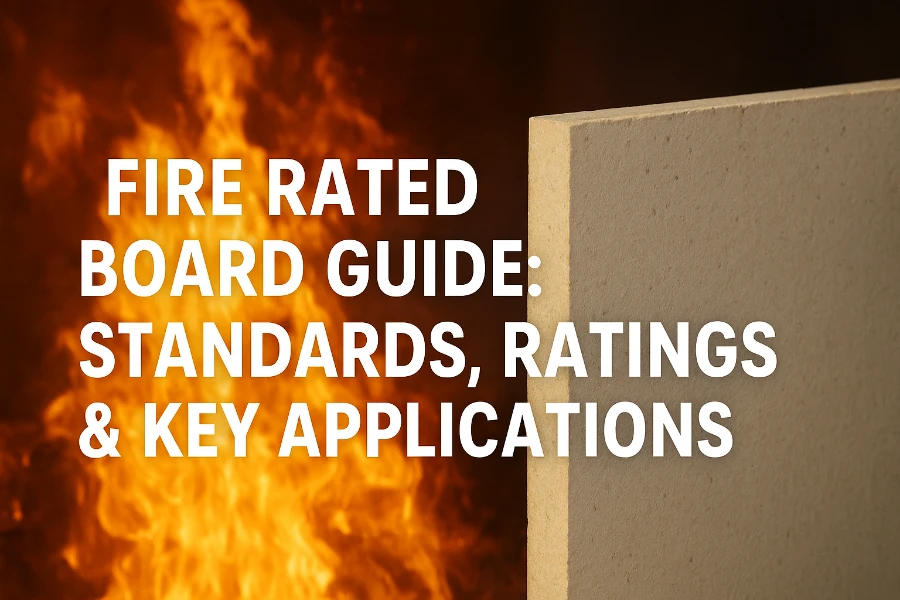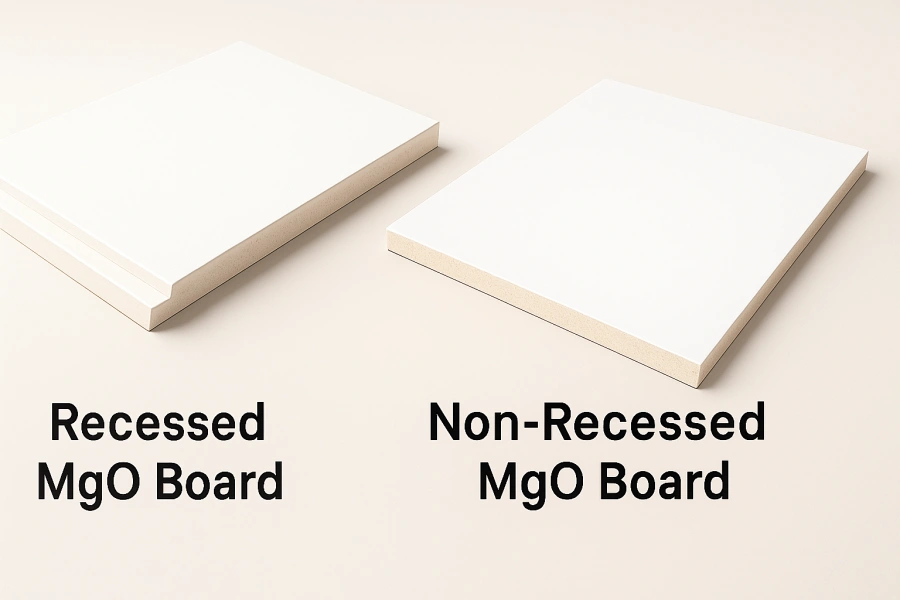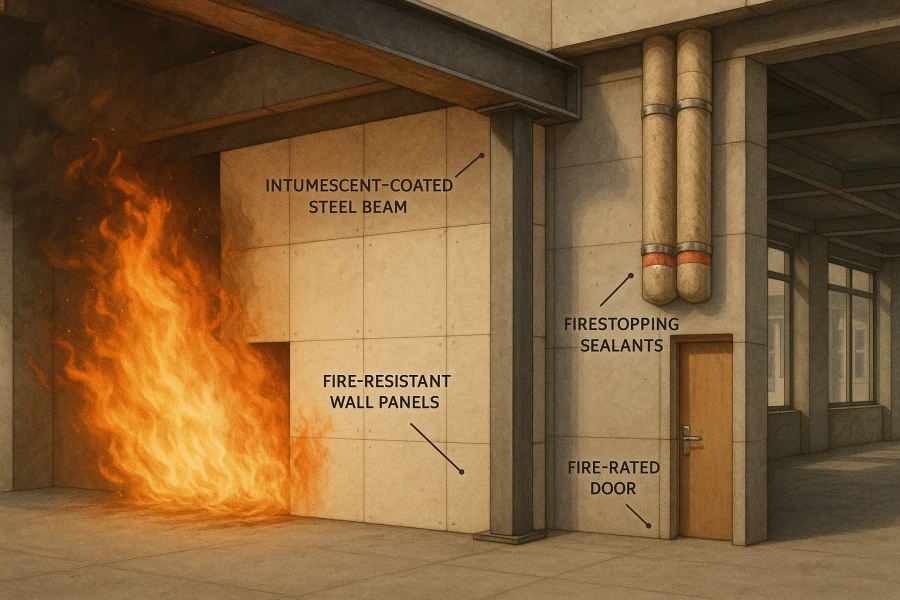Table of Contents
Ask Us Any Question
Introduction
In modern construction, safety is never negotiable. Among all risks, fire remains one of the most destructive threats to buildings and human lives. To reduce this risk, builders increasingly rely on fire rated board, a specialized material designed and certified to resist flames for a specific duration.
Unlike ordinary fire boards, which may provide some resistance, a fire rated board undergoes standardized testing to prove its performance. This makes it not just a product feature but also a compliance requirement in many regions. Whether it is a high-rise office, a hospital, or a public transit hub, fire rated boards are often the invisible shield protecting people and property.
What Is a Fire Rated Board?
A fire rated board is a construction material that has been tested and certified to withstand fire for a defined period, such as 30, 60, 90, or even 120 minutes. The key point is that the rating is not a claim from the manufacturer but the result of standardized laboratory testing according to international fire safety standards.
Fire Board vs. Fire Rated Board
-
Fire board: A broad term for any board that has fire-resistant properties. Examples include gypsum board, calcium silicate board, fiber cement board, and magnesium oxide (MgO) board. These materials may slow down flame spread but do not necessarily undergo strict certification.
-
Fire rated board: A narrower category that specifically refers to boards with proven performance in controlled fire tests. These boards must demonstrate structural integrity, heat insulation, and smoke resistance under test conditions.
In simple terms, all fire rated boards are fire boards, but not all fire boards can be considered fire rated. This distinction is crucial for engineers, contractors, and buyers who need materials that meet legal and safety obligations.
Fire Rating Standards Explained
Understanding the standards behind fire rated boards is essential for selecting the right material for any construction project. These standards are developed to ensure consistent, measurable, and reliable performance under fire conditions. They specify how long a board can withstand fire, how it maintains structural integrity, and how it limits heat transfer and smoke production.
International Standards
-
EN 13501 (Europe)
EN 13501 is the primary European standard for classifying building materials based on fire performance. Fire rated boards tested under this standard receive a classification such as A1 or A2, indicating non-combustibility, along with ratings for smoke emission and flaming droplets. For instance, a board classified as A2-s1, d0 is essentially non-combustible, produces minimal smoke, and does not release burning droplets. This level of detail helps architects and engineers choose materials that meet both local building codes and European regulations. -
ASTM E119 (United States)
In the U.S., ASTM E119 defines the fire resistance of building materials, including walls, ceilings, and floor assemblies. Boards are evaluated for how long they maintain load-bearing capacity, limit heat passage, and prevent flame spread. A fire rated board certified under ASTM E119 may be rated for 1-hour, 2-hour, or even 4-hour fire resistance, which directly informs its application in commercial, residential, or industrial buildings. -
BS 476 (United Kingdom)
BS 476 is one of the oldest and most widely recognized British fire standards. It assesses fire resistance based on integrity, insulation, and load-bearing capacity. Fire rated boards tested according to BS 476 provide critical information for building approvals in the UK, especially for high-risk structures such as hospitals, schools, and public transportation hubs.
How Testing Works
Testing involves exposing it to high temperatures under controlled conditions to evaluate several key factors:
-
Structural integrity: Can the board retain its shape and support weight without collapsing?
-
Insulation performance: How well does it prevent heat transfer to the other side, protecting occupants and structural components?
-
Smoke and droplet emission: Does it minimize smoke generation and prevent flaming debris from spreading?
Only boards that meet or exceed the specific criteria of these standards can be officially labeled as fire rated, giving buyers and regulators confidence that the material will perform reliably during a fire emergency.
Fire Rating Levels and Classifications
Fire rated boards are not all the same; they are classified according to the duration they can withstand fire and their performance during testing. Understanding these levels is crucial for specifying the right board for each project.
Common Fire Resistance Ratings
-
30-Minute Fire Rated Board
-
Can resist fire for 30 minutes before structural failure.
-
Often used in low-rise buildings or interior partitions where minimal fire exposure risk exists.
-
-
60-Minute Fire Rated Board
-
Maintains integrity for 1 hour under fire conditions.
-
Common in residential and commercial projects, providing enough time for evacuation.
-
-
90-Minute Fire Rated Board
-
Suitable for areas with higher fire safety requirements, such as stairwells, corridors, and some commercial ceilings.
-
-
120-Minute Fire Rated Board
-
Offers 2 hours of fire resistance, ideal for high-risk zones like hospitals, laboratories, industrial facilities, and high-rise buildings.
-
Interpreting Fire Test Reports
When selecting a fire rated board, understanding the fire test report is essential:
-
Rating duration: Confirms how long the board can resist fire.
-
Integrity and insulation values: Indicates whether the board can prevent flames and excessive heat from passing through.
-
Compliance marks: Look for certified logos from recognized standards bodies such as EN, ASTM, or BS.
A well-documented report ensures that the chosen fire rated board meets legal and safety requirements. Without proper certification, a board may appear fire-resistant but fail under real fire conditions, posing serious risk to life and property.
Practical Tip
Remember, higher-rated boards are not always required for every project. Over-specifying can increase cost unnecessarily. Consult building codes, fire safety regulations, and professional engineers to determine the appropriate fire rating for each application.

Key Applications of Fire Rated Boards
Fire rated boards are widely used in modern construction to enhance safety, protect property, and meet regulatory requirements. Their applications vary depending on the fire resistance rating, structural needs, and the type of building.
High-Rise Buildings
High-rise structures require strict fire safety measures because evacuation times are longer and risks are higher. Fire rated boards are commonly used in:
-
Interior walls and partitions
-
Ceilings and soffits
-
Stairwells and elevator shafts
By incorporating such boards, designers can ensure that fire compartments are properly maintained, slowing fire spread and allowing safe evacuation.
Hospitals and Schools
Healthcare and educational facilities host large numbers of people daily, making fire protection critical. Fire rated boards are used for:
-
Patient rooms and classrooms
-
Corridors and staircases
-
Operating theaters and laboratories (in hospitals)
These boards not only provide fire resistance but also maintain hygiene and durability, often being compatible with washable surfaces or antimicrobial coatings.
Public Transportation Hubs
Airports, metro stations, and bus terminals are high-traffic areas where fire emergencies can be catastrophic. Fire rated boards help in:
-
Tunnel linings and platform walls
-
Ceiling panels in terminals
-
Fire-rated doors and partitions
Using certified fire rated boards ensures compliance with stringent safety regulations and minimizes the risk of fire-related injuries.
Industrial Facilities and Warehouses
Industrial plants and storage facilities often contain flammable materials or equipment that could ignite a fire. Fire rated boards are applied in:
-
Partition walls between hazardous zones
-
Ceiling linings and false ceilings
-
Fire doors and enclosures around sensitive machinery
In these settings, the boards not only provide fire protection but also enhance structural durability and resist moisture or chemical exposure.
Residential Applications
Even in residential buildings, the boards can be applied in:
-
Kitchen walls or ceilings
-
Shared walls in apartments or condominiums
-
Home theaters or utility rooms
They offer homeowners peace of mind by increasing safety without significantly altering aesthetics.
Benefits Beyond Fire Safety
While fire rated boards are primarily valued for their ability to resist fire, they offer several additional benefits that make them a versatile choice in construction projects.
Enhanced Sound Insulation
Many fire rated boards provide excellent acoustic performance. This makes them ideal for:
-
Office partitions
-
Residential walls
-
Schools and hospitals
By reducing noise transmission, these boards contribute to comfort and privacy, enhancing the overall quality of the built environment.
Moisture and Durability Resistance
Certain types of fire rated boards, such as magnesium oxide (MgO) or fiber cement boards, are naturally resistant to moisture, mold, and corrosion. This makes them suitable for:
-
Bathrooms and kitchens
-
Basements
-
Industrial facilities with humid environments
Their durability ensures a longer lifespan, reducing maintenance costs and the need for frequent replacements.
Environmental Advantages
Many fire rated boards are made from eco-friendly or recyclable materials, reducing the environmental footprint of construction projects. Additionally, boards with low VOC (volatile organic compounds) content contribute to healthier indoor air quality, an important consideration for schools, hospitals, and residential buildings.
Structural Strength
Beyond fire and moisture resistance, fire rated boards often provide additional structural support to walls and ceilings. Some types can bear loads or reinforce partitions, giving engineers more flexibility in design.
Cost Efficiency in the Long Run
Though fire rated boards may have a higher upfront cost than standard boards, their combined benefits—fire safety, durability, and reduced maintenance—often make them more cost-effective over time.
How to Choose the Right Fire Rated Board
Selecting the appropriate fire rated board for a project is crucial for safety, compliance, and cost-effectiveness. Here are key considerations to guide your decision:
1. Determine Required Fire Rating
Start by reviewing local building codes and fire safety regulations. Depending on the building type and occupancy, you may need boards rated for:
-
30–60 minutes for low-risk residential or interior partitions
-
90–120 minutes for high-risk areas such as hospitals, industrial zones, or high-rise buildings
Choosing the correct fire rating ensures compliance and optimal protection without overspending.
2. Verify Certification and Test Reports
Always request official documentation from the manufacturer or supplier. Look for:
-
Certification logos from recognized standards (EN, ASTM, BS)
-
Fire test reports detailing duration, integrity, insulation, and smoke control
-
Batch numbers and manufacturing dates to ensure authenticity
3. Consider Material Type and Performance
Different fire rated boards offer varying additional properties:
-
MgO boards: Moisture-resistant, durable, eco-friendly
-
Calcium silicate boards: High temperature and load-bearing capability
-
Fiber cement boards: Strong and versatile, suitable for both interior and exterior
Assess which combination of fire rating and performance characteristics suits your project needs.
4. Evaluate Installation Requirements
Some boards are easier to cut, shape, and install, while others require specialized fasteners or joint systems. Factor in:
-
Labor cost and skill level
-
Compatibility with other construction materials (e.g., adhesives, coatings, tiles)
-
Maintenance considerations post-installation
5. Supplier Reliability
Choose suppliers with a proven track record of delivering certified, high-quality fire rated boards. Reliable suppliers can provide technical support, installation guidance, and post-purchase service, reducing project risk.
Conclusion
Fire rated boards play a critical role in modern construction, providing certified protection against fire while offering additional benefits such as sound insulation, moisture resistance, durability, and eco-friendliness. Unlike ordinary fire boards, fire rated boards are tested according to international standards like EN 13501, ASTM E119, or BS 476, ensuring reliable performance in real fire conditions.
Understanding fire ratings, choosing the right board for specific applications, and verifying certifications are essential steps for architects, contractors, and building owners. From high-rise buildings and hospitals to industrial facilities and residential projects, fire rated boards offer peace of mind and compliance with safety regulations.
If you are planning a project and want to ensure maximum safety and regulatory compliance, contact us today. Our team can provide expert guidance on selecting the right fire rated board for your specific needs, helping you protect both people and property efficiently.
Compare recessed vs non-recessed MgO boards. Learn features, applications, and tips to choose the right fire- and moisture-resistant board.
Passive fire protection materials slow fire spread, protect structures, and save lives. Learn about 5 effective materials for safer, compliant buildings.
Discover what magnesium oxide (MgO) is, its key properties, applications, and where to buy high-quality MgO.




